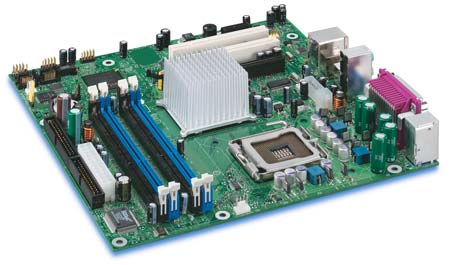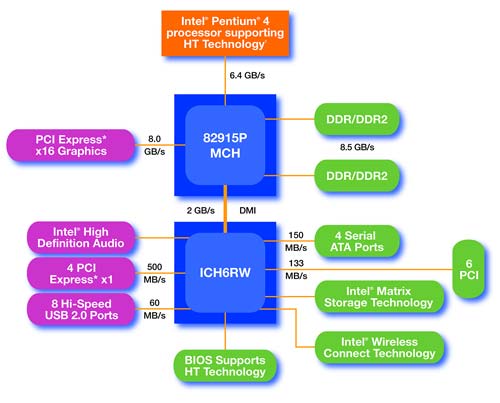Intel 925X/915: Chipset Performance & DDR2
by Wesley Fink on June 19, 2004 3:01 AM EST- Posted in
- CPUs
Intel 915G Express
Intel also provided a D915GUX motherboard for evaluation.
The 915 chipset comes in several flavors, both with and without the new Intel integrated graphics.

Most mainstream boards geared to AnandTech readers will feature the 915p chipset, without integrated graphics. The chipset is essentially a 925X without the acceleration technology, but with the added option of using either DDR or DDR2 memory, depending on what memory support the manufacturer chooses to provide. Other options are provided by the Southbridge and depend on which ICH6 version is paired with the 915P.

915G offers the same options as 915P, but adds Intel's integrated graphics. Intel has significantly upgraded integrated graphics for the 915 chipset, and now support DirectX 9 and OpenGL 1.4 on their integrated graphics. The new solution is called "Intel Graphics Media Accelerator 900". Intel claims that performance is doubled over Intel Intense Graphics 2. AnandTech takes a closer look at the performance of the new Intel integrated Graphics in the review of the Socket 775 CPU launch and PCIe Graphics that is the companion to this article. There is also an economy version of the 915 called 915GV, with integrated Media Accelerator 900 graphics, but without a PCIe 16X graphics card slot. We suspect that the 915GV will become a favorite of the Corporate desktop.

The D915GUX that we evaluated had all of the 915 features in a micro ATX form factor. Despite the smaller size, the D915GUX still provides integrated graphics, plus a PCIe 16X graphics slot, a PCIe 1X slot, and 2 PCI slots. All of the Intel boards, even the 915gux, provide 4 DIMM slots and support up to 4GB of memory. Please also notice that a 24-pin power connector, and not a 20-pin, is also a feature of 915 boards. 20-pin is backwards compatible, however, and the 24-pin is keyed to accept a standard 20-pin connector on one side of the new 24-pin.










57 Comments
View All Comments
gsellis - Saturday, June 19, 2004 - link
I am with #4 and #16, it is OK to leave the Northwood, but this is not apples to apples if you did not use two Prescotts to compare the boards to get a percentage difference in the architecture. The 'weak' areas almost match up to a Prescott vs Northwood comparison. It does not tell anything. Sorry Wesley, but the conclusion is flawed on a direct comparison.Bozo Galora - Saturday, June 19, 2004 - link
and notice the alderwood gigabyte only has the single red intel IDE, no greenieshttp://www.tomshardware.com/motherboard/20040619/i...
Bozo Galora - Saturday, June 19, 2004 - link
Tom's says new Intel chipsets are O/C locked - tied to PLLhttp://www.tomshardware.com/hardnews/20040619_1103...
Kahless - Saturday, June 19, 2004 - link
Am i missing something or is intel not as familiar with there own products as ATI...ie just read about ATI's chipset optimized for prescott and its faster than northwood which is a change from most benchmark comparisons on other boards ...http://www.anandtech.com/chipsets/showdoc.html?i=2...
ZobarStyl - Saturday, June 19, 2004 - link
Combined with the fact that they gonna start putting all this new tech on BTX format, Intel is really trying hard to completely remove itself from the DIY market. And although your average computer buyer doesn't even know what an AMD processor is, you can bet that OEM's are too happy about being asked to either a) swallow the cost of these upgrades or b) raise prices and lose customers, and this might make them eye AMD as a way to shore up the bottom line. Being a trendsetter is one thing but bringing in DDRII when it's slower and PCI-E when it offers practically no benefit isn't exactly blazing a trail that I want to follow...JustAnAverageGuy - Saturday, June 19, 2004 - link
"AMD is too pricey and Intel performance is pathetic"I can honestly say that is the FIRST time I have ever read that phrase.
Falloutboy525 - Saturday, June 19, 2004 - link
from what i've read on ddr2 it won't start make a big performance difference unless its clocked almost twice the speed as the ddr1 your compairing it to due to the fact all ddr2 is is 2 ddr1 chips dual channeld run thru a buffer. so when your running at 400mhz ddr2 the latency is the same as ddr200 due to the speed the chips are running at not the external frequency.Marlin1975 - Saturday, June 19, 2004 - link
"AMD is too pricey"WTF?
You can get a Athlon64 chip for less then $199 now and there is a sempron 3100+ socket 754 chip that has a MSRP of only $124
AMD hsa the best bang for the buck if you want low/mid end (atlon XP) or even mid/high end (Athlon 64/fx)
I went from a 800Mhz FSB HT P4 to a Athlon64 and and glad I did.
Zebo - Saturday, June 19, 2004 - link
"AMD is too pricey and Intel performance is pathetic"I agree socket 939 is way overpriced, especially for the underdog AMD who has an opporunity to make real enroads into the market with Intel down right now... but the rest of this is untrue. Socket 754 3200+ is the same price and P4 3.2 and they split the benchmarks. I'd argue for gamers the A64 3200+ is underpriced. Then intels performance is just fine unless you call 5-10% differences here and there signifigant. I don't and i doubt you'd even notice without charts to prove it.
tfranzese - Saturday, June 19, 2004 - link
"AMD performs great till you give it too much to do at once, and they won't fix that till they bring in dual core."Every processor is like this, Hyper-Threading doesn't save any Intel chip from this same thing. Benchmarks like Winstone, etc are benchmarking with multitasking in mind.
"AMD is too pricey and Intel performance is pathetic"
lol, it's ironic, but I'm glad AMD is where they are. They certainly aren't the same company there were 8 years ago.